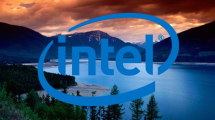Intel's recent generations of CPU have been characterized by a slow progression in incremental upgrades, and haven't helped keep your own products at a distance from AMD's from generation to generation.
Instead, it seems more aptly worded that AMD has fallen short of its own beat rhythm. However, the Ryzen CPUs are now on the verge of the official launch – so it is time to resume speculation. We cannot, of course, yet predict what this clash will be like. But when it comes to reviving the desktop market, you're obviously reliant on competitive AMD products.
Intel's announcement that it is moving away from the well-known tick-tock principle has already prepared us for the fact that the differences between processor generations could be even smaller than before – and Kaby Lake meets expectations (or: Fears?).
Intel relies on the same architectural basis as before, so there are no more computing cores, no increase in IPC performance or additional cache – nothing that could make us cheer. By default, the Kaby Lake CPUs perform almost identically to slightly overclocked models of the previous Skylake generation, when they are brought to identical clock frequencies by slight overclocking.
However, Kaby Lake promises overclockers to reach the magic 5 GHz limit. Apart from the slightly higher clock rates (around 200 to 300 MHz) compared to Skylake in general, there is no real reason to switch from an existing Skylake platform to Kaby Lake. If you already have a strong Skylake platform, you better invest in a new graphics card or SSD – because Kaby Lake really only offers an upgrade if you replace an outdated (Sandy Bridge and earlier) and slow PC system with a new platform. Wants.

Intel's drilled media capabilities are a nice touch for mainstream desktop users and notebooks, and power capture and power. the cpu utilization is sometimes significantly lower when the integrated graphics unit is set. All of this does not benefit owners of high-performance systems with bold graphics cards, as they will probably never use the economical integrated graphics solution – and with its high-end CPUs, Intel addresses exactly these users in the PC sector; no Office PC needs a processor that costs 350 euros or more.
As long as 4K content continues to be sparsely offered, the touted possibilities for streaming correspondingly high-resolution material are also interesting for marginal groups at best.
The new 200-series motherboard chipsets offer more HSIO lanes than the 100 series, giving motherboard manufacturers more leeway. But these possibilities are at least partially cancelled by a very restrictive DMI 3.0 link.
As a further advantage of the new PCH, Intel is using compatibility with 3D XPoint memory, which is available at Intel under the "Optane" label. Although this future memory on paper sounds very promising, it is not even ready for the market at present. Currently, Intel is also promoting it primarily as a cache for mechanical hard drives, which in turn could indicate questionable performance values compared to existing Performance class SSDs.
However, the real strength of 3D XPoint is likely to be in the field of application as a favorable addition to the DRAM and this could indeed mean a small revolution. However, we will probably have to wait until at least the next generation for this feature.
The Core i7-7700K is a powerful processor, but it also eats a considerable amount of waste heat. This can lead to it quickly reaching its thermal limit in the event of aggressive overclocking: powerful cooling is then a must. The smaller Core i5-7600K seems to be the more balanced choice and offers more (thermal) leeway, but it lacks hyper-threading and it brings the lower clock frequency from the house. The Core i5-7600, on the other hand, offers a very balanced balance of performance and efficiency; However, the lack of an open multiplier places tough limits on overclocking by limiting it to BCLK adjustments.
An AVX offset mode is a nice entry, but Intel would have done better to donate the Kaby Lake CPUs Turbo Boost 3.0. The Core i3-7350K seems to be a more than tempting alternative to the Pentium G3258, but we will not make such a recommendation until we have done our own tests and measurements.
In terms of price, Kaby Lake is fortunately oriented towards the previous generation, because without real competition, Intel is free to design the prices at its own discretion. If you are currently planning a new Desktop system based on Kaby Lake, you should be sure to purchase a powerful water cooling system and – if you don't already have it – also a Windows 10 license.
- 1 - Einleitung
- 2 - Z270, Optane, Overclocking-Tools und HD Graphics 630
- 3 - Test-Setup und Overclocking
- 4 - Benchmarks: Rendering und Office
- 5 - Benchmarks: Workstation-Anwendungen
- 6 - Benchmarks: DTP und Multimedia
- 7 - Benchmarks: Gaming und integrierte Grafik (iGP)
- 8 - Core i7-7700K: Leistungsaufnahme & Temperaturen
- 9 - Core i7-7700: Leistungsaufnahme & Temperaturen
- 10 - Core i5-7600K: Leistungsaufnahme & Temperaturen
- 11 - Core i5-7600: Leistungsaufnahme & Temperaturen
- 12 - Unterschiedliche Chipqualität und ihre Folgen
- 13 - Fazit
































Kommentieren